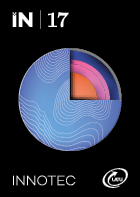Comparison of different extraction methods for the lipids profile determination in quinoa seeds
DOI:
https://doi.org/10.26461/17.08Keywords:
quinoa, GC-MS, GC-FID, Soxhlet, dynamic maceration, ultrasonic assisted macerationAbstract
In this work, three different methods for the extraction of lipids were compared in quinoa seeds: dynamic maceration with hexane, maceration with hexane assisted by ultrasound and continuous extraction in Soxhlet using an increasing polarity gradient of solvents (hexane, ethyl acetate and methanol). Method performance was evaluated thorough lipid extraction yield and the extracts were subjected to derivatization to generate the corresponding fatty acids methyl esters (FAMEs). All the obtained fractions (the extracts and FAMEs) were analyzed by thin layer chromatography, showing that the extraction methods using hexane as solvent presented spots of similar intensity and retention factor, while the extracts obtained with ethyl acetate and methanol showed spots with different retention factor. The different fractions of FAMEs were analyzed by gas chromatography using flame ionization detector and mass spectrometry, and nuclear magnetic resonance. Using GC-FID the following fatty acids were identified; C14: 0, C16: 0, C18: 0, C18: 1, C18: 2; C18: 3 and C20: 1. The analysis by GC-MS allowed the confirmation of C16: 0; C18: 0; C18: 1; C18: 2.
Downloads
References
Darnoko, D. y Cheryan, M., 2000. Continuous production of palm methyl esters. En: Journal of the American Oil Chemists' Society, 77, pp.1269-1272.
Fanali, C., Beccaria, M., Salivo, S., Tranchida, P., Tripodo, G., Farnetti, S., Dugo, L., Dugo, P. y Mondello, L., 2015. Non-polar lipids characterization of Quinoa (Chenopodium quinoa) seed by comprehensive two-dimensional gas chromatography with flame ionization/mass spectrometry detection and non-aqueous reversed-phased liquid chromatography with atmospheric pressure chemical ionization mass spectrometry detection. En: Journal of Separation Science, 38, pp.3151-3160.
Huang, Z., Zhang, P., Sun, Y., Huang, Y., Pan, Z. y Wang, L., 2015. Determination of glyceride and free fatty acid residuals in biodiesel by thin layer chromatography combined with on-line pyrolytic methylation gas chromatography. En: Journal of Analytical and Applied Pyrolysis, 113, pp.288–295.
Marmouzi, I., El Madani, N., Charrouf, Z., Cherrah, Y. y El Abbes Faouzi, M.Y, 2015. Poximate analysis, fatty acids and mineral composition of processed Moroccan Chenopodium quinoa Willd. and antioxidant properties according to the polarity En: Phytothéapie, 13, pp.110-117.
Pellegrini, M., Lucas-Gonzales, R., Ricci, A., Fontecha, J., Fernández-López, J., Pérez-Álvarez, J.A. y Viuda-Martos, M., 2018. Chemical, fatty acid, polyphenolic profile, techno-functional and antioxidant properties of flours obtained from quinoa (Chenopodium quinoa Willd) seeds En: Industrial Crops & Products, 111, pp.38–46.
Prego, I., Maldonado, S. y Otegui, M., 1998. Seed structure and local
ization of reserves in Chenopodium quinoa. En: Annals of Botany, 82, pp.481-488.
Przybylski, R., Chauhan, G.S y Eskin, N.A.M, 1994. Characterization of quinoa (Chenopodium quinoa) lipids. En: Food Chemistry, 51, pp.187-192.
Rubio, Y., 2005. Extracción de aceite de quinoa (Chenopodium quinoa willd) y su caracterización de dos ecotipos provenientes del secano costero de la región VI de Chile [En línea]. Santiago: Universidad de Chile. [Consulta: 18 de octubre de 2018]. Disponible en: http://repositorio.uchile.cl/tesis/uchile/2005/rubio_y/sources/rubio_y.pdf
Published
How to Cite
Issue
Section
License
Los autores del manuscrito declaran conocer y aceptar los siguientes términos de responsabilidad:
Haber participado lo suficiente en el trabajo como para hacer pública la responsabilidad por su contenido.
Que el manuscrito representa un trabajo original que no fue publicado ni está siendo considerado por otra revista para su publicación, en parte o en forma íntegra, tanto impresa como electrónica.
Que en caso de ser solicitado, procurará o cooperará en la obtención y suministro de datos sobre los cuales el manuscrito esté basado.
Declara que la información divulgada que pudiera pertenecer a un tercero cuenta con la autorización correspondiente.
Autorización para la publicación y compromiso de cita de primera publicación
Los autores/as conservan los derechos de autor y ceden a la revista INNOTEC / INNOTEC Gestión el derecho de la primera publicación, con el trabajo registrado con la licencia de atribución Creative Commons Reconocimiento-NoComercial 4.0 Internacional. Creative Commons, que permite a terceros utilizar lo publicado siempre que mencionen la autoría del trabajo y a la primera publicación en esta revista sin fines comerciales.
El autor se compromete a realizar la cita completa de la edición institucional de esta primer publicación en las siguientes publicaciones -completas o parciales- efectuadas en cualquier otro medio de divulgación, impreso o electrónico.
Los autores/as pueden realizar otros acuerdos contractuales no comerciales independientes y adicionales para la distribución no exclusiva de la versión del artículo publicado en esta revista (p. ej., incluirlo en un repositorio institucional o publicarlo en un libro) siempre que indiquen claramente que el trabajo se publicó por primera vez en esta revista.
Se permite a los autores/as publicar su trabajo en Internet (por ejemplo en páginas institucionales o personales) antes y durante el proceso de revisión, ya que puede conducir a intercambios productivos y a una mayor y más rápida difusión del trabajo publicado (vea The Effect of Open Access). A su vez los autores/as autorizan al LATU a publicar el trabajo en su repositorio digital.
Los conceptos y opiniones vertidos en los artículos son de responsabilidad de sus autores.
Este obra está bajo una licencia Reconocimiento-NoComercial 4.0 Internacional.












